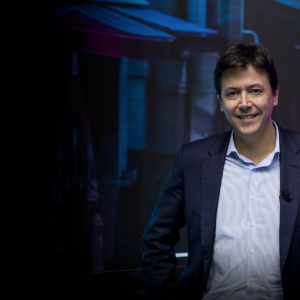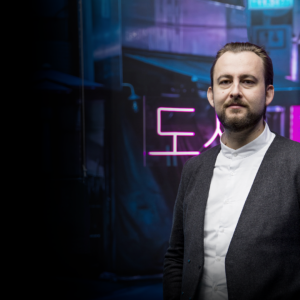Picture the city of the future in your mind. What do you see? Maybe your vision is inspired by popular culture: Orbit City from The Jetsons, with its flying vehicles and bubble homes; or the organic structures and levitation trains of Golden City, in Black Panther’s Wakanda; perhaps the walled enclave of Academy City from the anime series A Certain Magical Index.
Glimpses of the city of tomorrow can even be seen today in places all around the world. One such example: the Dongdaemun Design Plaza (DDP) in Seoul, a building imagined and built to explore how sustainable cities can thrive as urbanization increases. The DDP is one of the influencing factors behind Seoul’s designation in 2010 as World Design Capital.
Our cities must address key challenges. UN Habitat, the United Nations Human Settlements initiative that promotes socially and environmentally sustainable towns and cities, predicts that by 2050 the urban population in Asia is expected to grow by 50% – an additional 1.2 billion people. With city populations and climate issues both rising, urban areas pose significant challenges, and opportunities, for sustainable development.
In January 2023, Dassault Systèmes revealed Urban Renaissance, a stunning 3D mapping project by Korean artist and researcher Yiyun Kang to illustrate the city of tomorrow, which was showcased in a talkshow alongside an engaging expert panel discussion. Urban Renaissance is the most recent installment in ‘The Only Progress is Human’ initiative, which seeks to inspire people by shining a spotlight on the 10 biggest challenges of our age and how humanity may help solve them.
As part of the initiative, we spoke with three visionary leaders about their work, the role of smart cities and their vision of the future: YiyungKang, architect Bogdan Zaha of Zaha Hadid Architects and Dassault Systèmes’ Jacques Beltran, Vice President, Cities & Public Services. Their values and motivation are focused on building beautiful, smart, sustainable cities:

Yiyun Kang holds a PhD in Information Experience Design from the School of Communication at Royal College of Art, London. Her projection mapping installations have been featured in museums around the world.

Jacques Beltran aims to accelerate the digital transformation of cities and public administrations by leveraging the power of virtual twin technology.

Bogdan Zaha: has a PhD fellowship from the University of Applied Arts in Vienna. His design career includes projects that span the globe, and include Beijing Daxing International Airport, Science Centre Singapore, Zugló City Centre in Budapest.
3DS: How do you envision the city of the future?
Beltran::The United Nations predicts that 68% of the worldwide population will live in cities by 2050, versus 54% today. This is a huge transformation. And in the meantime, cities will face growing challenges related to this demographic pressure of course, traffic congestion for example, but also to external phenomena such as climate change.
In this context, the most attractive cities will be those that succeed in accommodating the various experiences of cities:focusing on children, students, workers and elderly people. Each group requires different infrastructures and services. Cities of the future will have to adapt both to the growing challenges and to the diverse expectations of their citizens.
Kang: I think our city will be very different from what we have now, in terms of shape, population, environment and geo-political structure. The future city needs to be a creative and innovative hub that challenges or disrupts the existing perspective. I believe reclaiming the connection with other entities should be the priority in designing the future city.
Here’s a replay of the LIVE event:
3DS: What are the big changes you foresee in the city of the future?
Zaha: As we’ve already started experiencing during the Pandemic, the way we live, and work has changed to some extent. We are, or at least should be more conscious about the environment and how it affects our well-being. One of the changes deriving from that is the way we interact with each other both physically, within buildings and public spaces, but also with our surroundings. There is a need for integrating nature within our built environment and to re-naturalize our surroundings. The way we design our buildings and cities should reflect those needs in terms of sustainability, mobility, and ultimately our own living standards.
3DS: Who are the main players building the city of the future?
Kang: The main players of the city of tomorrow should be its citizens. I think the most important thing is building a collective mindset, that is eco-friendly, sustainable yet progressive, and to understand the causal relationship between human and non-human entities.
Simultaneously, technical assistance is needed to address the critical problems facing the city. Therefore, technological advances led by brilliant minds, such as Dassault Systèmes have a very substantial role in building our future city. It could be a catalyst and enabler to make our future city a sustainable one.
3DS: How can people get involved? How can we feel like we’re making a difference?
Zaha::Communication is key. I think that activism within different social groups and different countries is coming more to the forefront of society. It is very important to be active and voice out your thinking and what your wishes are in a reasonable way. People need to get involved. By doing so it is easier for professionals to consider all the needs because whether you are a city planner, architect, government or local authority, each one has their own view of the requirements necessary to improve city life.
That’s the good thing about more developed systems or systems where you have more people – because we are saying that yes, cities are creating so much pollution and having such a great impact on the environment, but on the other hand, for such a large population that the globe has, the solution is nothing but cities. The solution isn’t to go back, it’s figuring out how to better consume. We can do this by coming together. We’ve got to make cities work.
3DS: What are the biggest challenges the city of tomorrow has to overcome?
Kang: The future city will be more confronted with the extreme environmental crisis, shrinking population, energy problems, exterminating species, pandemics, and political implications. They are all intertwined challenges, and we all know that it is going to be very difficult to deal with these problems.
Beltran: City leaders are under huge pressure to deliver long term urban planning strategies to achieve sustainable objectives, and also anticipate and react to crises relating to health, natural disasters, energy supply or resources. Cities now have access to tremendous volumes of data. This is a major opportunity for them to better understand the complexity of their territory, prevent or anticipate crises by simulating various scenarios, and take science-based decisions while ensuring data security and sovereignty.
3DS: What will help make cities both more sustainable and more livable?
Beltran: Virtual twin technology is a key solution for cities that want to prepare to meet these challenges and expectations. A science-based virtual representation of a city is the only way to understand the reality of a city and the experiences of its citizens, and to plan for the future. For example, it is said that in 2050, the city of Bordeaux in France will experience the same weather conditions as what Seville in Spain currently has.
What does it mean for the people in Bordeaux? How can the city adapt to temperatures around 45° Celsius? What impact will this have on public transportation infrastructure? What impact will it have on the general attractiveness of the city for businesses?
Virtual twin technology can help cities facing such challenges by simulating the impact of such phenomena, build the “what if” scenarios, choose the most appropriate measures and communicate with citizens to explain their rationale.
3DS: How can we help ensure a better quality of city life in the future?
Zaha: We’re known for using data in our design as the main driver. That’s why we call ourselves parametric modelers. One thing to consider, which is about individuals, is how you use that data to create a better understanding among individuals to create collaboration. And for that, you need communication.
For a simpler understanding about what data is, think back to the pandemic when everybody was going on Google and typing in ‘COVID-19’ – you’d then get all those stats by which we almost regulated our activities, in the sense that you saw numbers spiking up and you thought, ‘I don’t know if I will go to this event today or tomorrow or go out to the shops’.
So, similarly as architects, we try to design based on similar kinds of data inputs in a sense of judging how people would be able to use the space and try to create tendencies of usage. How would you like spaces to be used and by what you provide within that space as offering for people? People have needs and our job is to make them access those needs in a much easier, convenient pleasant experience. That’s our job as architects – for you to feel the space.
3DS: What does ‘The Only Progress is Human’ mean to you?
Beltran: Cities are, by essence, the place of human interaction. Transforming cities to make them more livable is at the heart of the mission of all city leaders. It is all about harmonizing product [buildings, infrastructures, networks], nature [quality of air, green spaces, water] and life.
Kang: This term progress has a two-fold meaning to me. Behind our remarkable progress are all these chaotic problems that humanity has caused. We are the ones who have the power to destroy and develop simultaneously. From now on, progress has to retain responsibility. We should consider the result, the consequences of our actions, at every step of the progress. Therefore, “The Only Progress is Human” means to me that humanity holds the key to genuine progress.

